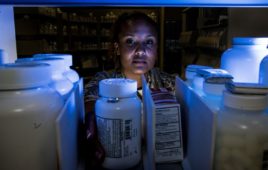Catching cancer early can make all the difference for successful treatment. A common screening practice measures tumor growth with X-ray computed tomography (CT), which takes a series of cross-section images of the body.
Before they are used in clinics, researchers test multiple CT imaging techniques with standard objects called “phantoms,” designed to mimic real tumors. Phantoms allow researchers to simulate a typical cancer screening in the lab, and predict how accurately real tumors will be measured by a particular technique.
However, the complex shapes and fuzzy boundaries of real tumors have been difficult to capture in a tumor phantom, typically made of 3-D printed plastic. In pursuit of a better phantom for improved tumor measurements, scientists at the National Institute of Standards and Technology (NIST) hit upon an effective but unconventional solution: injecting water into disposable diapers.
“It may sound strange, but it turns out that water in a disposable diaper closely resembles the structure of a tumor in tissue,” explains NIST physicist Zachary Levine, the lead author of a new report published in the NIST Journal of Research. “Moreover, we can grow these tumors just like real ones, by simply adding more water.”
These ordinary ingredients could help resolve a decade-long question about the best way of interpreting CT images: When tracking tumor growth, is it better to measure length or volume?
The length approach is part of a widely used standard called RECIST (Response Evaluation Criteria in Solid Tumors), originally proposed in 2000. Using RECIST, a tumor’s size is determined by its largest measured length in any CT slice. A change in size is simply a change in this length. This method comes from early X-ray CT, when two-dimensional images were rendered onto film and various features measured by hand.
Volumetric measurement, on the other hand, combines all the two-dimensional slices to form a three-dimensional volume. Hidden structures can be revealed by looking for boundaries within this volume. This approach is relatively new, and researchers are still figuring out how accurate it is at measuring tumor mass compared to other techniques.
To compare the two methods, the NIST team loaded multiple diapers with a small initial volume of water and imaged each diaper with X-ray CT. They then repeatedly injected more water and re-scanned each diaper, weighing them before and after to precisely determine the amount of water added. Then they estimated the water mass at each step using both volumetric measurements and RECIST.
With the improved diaper phantoms, the volumetric approach came out on top, outperforming RECIST by at least a factor of five in estimating the mass for each phantom. These experimental results suggest that for real tumors, measuring the volume could be a more reliable predictor of mass than the RECIST length.
“The hope is that in the next review of RECIST, this body of work will help to show that volumetric measurements are convincingly better,” says Levine. Adopting more accurate methods could enable physicians to screen for tumors even earlier, and quickly determine if a particular treatment is working.
Source: NIST



